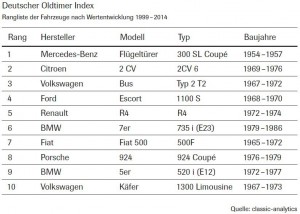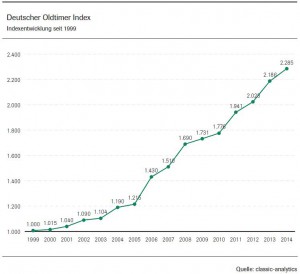
(English below)
Der durchschnittliche Wert von historischen Kraftfahrzeugen ist im vergangenen Jahr erneut gestiegen, allerdings mit etwas geringerer Geschwindigkeit.
Der Deutsche Oldtimer Index, den der Verband der Automobilindustrie (VDA) herausgibt, legte 2014 um 4,5 Prozent zu. Damit stieg der Index 2014 von 2.186 auf 2.285 Punkte. 2013 hatte er noch ein Plus von über 8 Prozent erreicht. Damit bestätigt sich ein Muster der vergangenen Jahre: Nach Phasen mit stärkerem Wertzuwachs folgen in der Regel Phasen mit einem geringeren Anstieg. Langfristig zeigt der Deutsche Oldtimer Index eine klar positive Tendenz nach oben.
Platz eins in der Rangliste der Fahrzeuge mit dem höchsten Wertzuwachs gegenüber dem Vorjahr hat die Sportwagen-Legende Mercedes-Benz 300 SL (Flügeltürer) erobert (Vorjahr: Platz zwei). Dahinter folgt ein bekannter US-Amerikaner: Der Chevrolet Camaro der Baujahre 1978 bis 1981 war bereits 2012 Zweitbester im Wertzuwachs. Den dritten Rang belegt das Mercedes-Benz 500 SEC Coupé (W 126), das von 1985 bis 1991 gebaut wurde.
Dahinter folgt der Volvo PV 544 (Baujahre 1961-1965). Zwei Opel-Modelle belegen die Plätze fünf und sechs: Der Opel Commodore, eine Limousine der oberen Mittelklasse (1969-1971) mit Reihensechszylinder, und dahinter der etwas schwächer motorisierte Opel Rekord C 1700 (1968-1971). Der Opel Ascona B (1975-1981) schafft es auf Platz zehn. Damit sind historische Opel-Modelle 2014 in den Top Ten am stärksten vertreten.
Der Mercedes-Benz 300 SL (Flügeltürer) legt nicht nur im Vorjahresvergleich am stärksten zu: Der Wagen führt auch die Rangliste der Fahrzeuge mit dem stärksten Wertzuwachs seit Beginn der Index-Berechnung 1999 an. Platz zwei teilen sich automobile Legenden aus dem Volumensegment: die „Ente“ (Citroën 2CV 6) und der VW „Bulli“ (VW Bus Typ 2 T2). Beide Fahrzeuge haben ihre hohen Wertzuwächse in den vergangenen 15 Jahren auch einem relativ geringen Ausgangsniveau zu verdanken. Es folgen weitere Modelle aus dem Segment der Alltagsfahrzeuge der 1970er Jahre: der Ford Escort 1100 S (1968-1970) und dahinter der Renault R4 (1972-1974).
Im Oldtimer-Markt lassen sich verstärkt zwei voneinander zunehmend unabhängige Segmente beobachten. Einerseits wurden auf öffentlichen Auktionen für selten gebaute Fahrzeuge, Einzelstücke oder Rennwagen, nicht selten mit berühmten Vorbesitzern, im vergangenen Jahr Rekordpreise erzielt. Dieser Bereich ist für den gesamten Oldtimermarkt jedoch wenig repräsentativ, denn hier wird häufig unter dem Gesichtspunkt der Geldanlage in Sachwerten gekauft.
Auf der anderen Seite stehen die echten Oldtimer-Enthusiasten, die sich unabhängig vom Seltenheitswert oder Wertsteigerungspotenzial für ihre Fahrzeuge begeistern. Sie geben im Durchschnitt für ein historisches Fahrzeug deutlich weniger als 20.000 Euro aus. Der Wertzuwachs dieser Fahrzeuge kompensiert in der Regel nicht die stetig anfallenden Wartungs- und Unterhaltskosten. Solche Fahrzeuge bilden auch den Kern des Deutschen Oldtimer Index: Hier werden keine Einzelstücke aufgenommen, sondern nur Fahrzeuge, von denen eine gewisse Stückzahl gebaut und auch heute noch gehandelt wird. Die Basis des Index bilden Daten des Bochumer Bewertungsspezialisten classic-analytics. Für die Ermittlung des Index werden 88 Fahrzeuge ausgewählt, die aufgrund ihrer Spezifikationen, ihres Herstellerlandes sowie ihrer Häufigkeit den deutschen Oldtimer-Markt repräsentativ abbilden. Die aktuellen Zulassungszahlen werden bei der Berechnung berücksichtigt.
Hier der Anhang:
Oldtimer 2015 Index Rangliste Wertentwicklung
Oldtimer 2015 Index_Rangliste Wertentwicklung Vorjahr
Oldtimer 2015 Index seit 1999 (PDF)
—–
Latest Report of The Association of the German Automotive Industry: Historic Vehicle Index Risen in Germany in 2014
(Translation by Amicale:)
The average value of historic motor vehicles rose again last year, but at a slower rate.
The German “Oldtimer Index” (note by Amicale: “Oldtimer” is the term used in Germany for vehicles which are older than 30 years) that the Association of the German Automotive Industry publishes (VDA), went up in 2014 by 4.5 percent. The index rose from 2,186 to 2,285 points. 2013 it had an increase of over 8 percent. This results confirmes a trend of the recent years: After periods of greater value growth phases usually a period follows with a smaller increase. In the long term the “German Oldtimer Index” shows a clearly positive upward trend.
First place in the ranking of vehicles with the highest increase over the previous year is held by the legendary sports car Mercedes-Benz 300SL (“Gullwing”) (previous year: ranked number two). Following up is a well-known American: The Chevrolet “Camaro” model years 1978 to 1981 was in 2012 the second best in appreciation. The third place is taken by the Mercedes-Benz 500 SEC Coupé (W 126), which was built from 1985 to 1991.
Next comes the Volvo PV 544 (model years 1961-1965). Two Opel models occupy positions five and six: The Opel Commodore, a sedan of the upper middle class (1969-1971) with six-cylinder, and behind the somewhat weaker motorized Opel Rekord C 1700 (1968-1971). The Opel Ascona B (1975-1981) is on tenth place. These historical Opel models were the most represented in the top ten in 2014.
The Mercedes-Benz 300 SL (“Gullwing”) also made it to the top of a list on another characteristics: this car also leads the ranking of vehicles with the most compelling value since the beginning of 1999, the index calculation. Place two share automotive legends from the volume segment: the “duck” (Citroën 2CV) and the VW “Bulli” (VW Bus Type 2 T2).
Both vehicles owe their high value growth over the past 15 years, a relatively low starting point. The following are additional models from the segment of everyday vehicles of the 1970s: the Ford Escort 1100 S (1968-1970), followed by the Renault R4 (1972-1974).
In the classic car market one can observed two independent trends. On the one hand during the last year, record prices could be achieved on public auctions for rare-built vehicles, unique vehicles or racing cars, often also when there were famous previous owners. However, this trend is not representing the entire classic car market because the activities are mainly representing an investment interest in buying vintage vehicles, comparing to real estate investments.
On the other side are the true classic car enthusiasts who admire regardless of rarity or value a potential for their vehicles. They spend an average significantly less than 20,000 euros when purchasing a historic vehicle. The market value of these vehicles respectively their value increase typically does not compensate the required maintenance and upkeep costs for these vehicles though.
Such vehicles are at the heart of the “German Oldtimer Index”: Here, no unique cars or auction results are being recorded, but only those vehicles of which a certain number of units were built and are still traded. This index data is maintained by the Bochum-based valuation specialist company “classic-analytics”. For the calculation of this index, 88 vehicles are selected that represent the German classic car market due to their specifications, their country of manufacture as well as their existing numbers. The current registration figures are included in the calculation.
Details in the a.m. links (graphics and PDF).
Thanks to the VDA for sharing this information with us.


